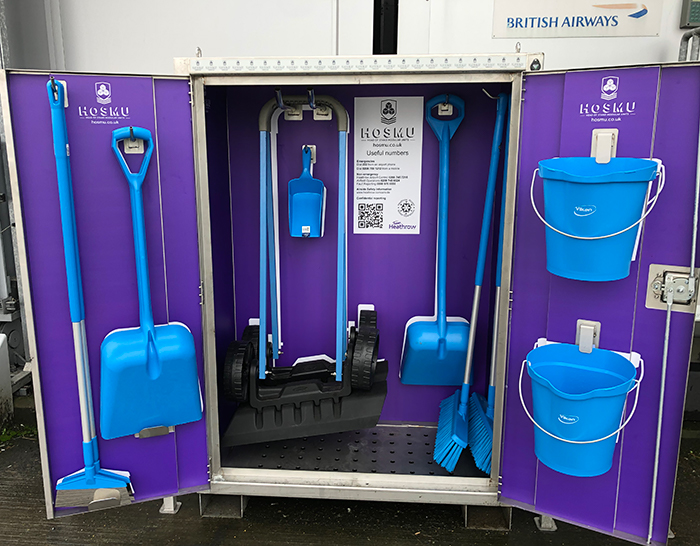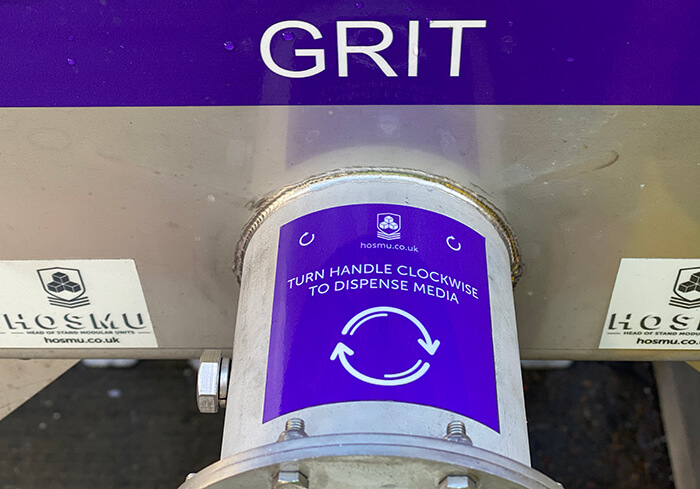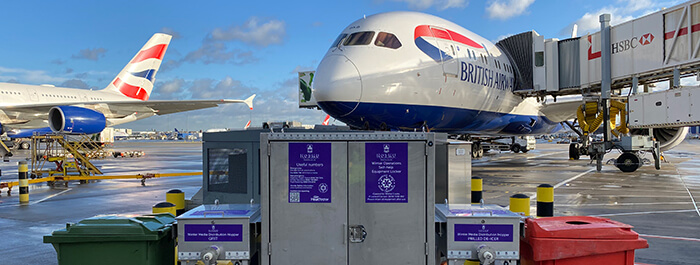Hythe HOSMU provides storage & distribution solutions for Heathrow Airport
Contact us
Who and what is HOSMU?
HOSMU is a Hythe Group company which was introduced to support the mass production of custom metal fabrication projects, providing innovative solutions to customers’ storage and distribution challenges.
The HOSMU concept was developed in partnership with Heathrow Airfield Operations, the safety and workplace supplier, Our Soles Ltd. and proven engineering specialists, Hythe Marine Services.
The resulting turnkey solution is a concept driven, manufacturing business capable of designing, delivering and implementing consolidated and organised storage of essential resilience equipment.
This process has been designed to give customers the highest quality solutions, based on Hythe Marine Services knowledge and experience from the marine sector, including cost efficiencies and speed of a production line.
The Heathrow Airport project
Hythe HOSMU was installed airside at Heathrow Airport in readiness for winter 2019/20. The installation provided a new solution for a consolidated, single point of collection, for essential winter resilience operating equipment.
Operational efficiencies are instantly improved by placing all equipment into one modular system (situated in multiple locations airside) which ensure self-help snow and ice clearance equipment is organised and readily available. By providing a clear focal point for organistaion and storage HOSMU ensures operational equipment is returned, reducing the likelihood of trip hazards whilst lowering the need for tool replenishment.
The HOSMU for each stand or airside location is assembled depending upon the footprint and operational requirements of the area. Each unit can contain a number of functions such as:
- Winter operations locker
- Winter media distribution hopper
- FOD (Foreign Object Debris) and POL (Polluted waste) wheelie bin storage

What was the problem Heathrow Airport’s winter resilience team faced?
You might be wondering what winter resilience really means? Heathrow has a team specifically dedicated to winter operations and they are entrusted to plan, prepare and manage robust strategies and resources for effective winter resilience. This may concern the shocks and stresses of winter weather, such as snow and ice, which impact airport operations.
Heathrow provides a number of useful tools and consumables which are kept in strategic areas of the airport for use by stakeholders and contractors as ‘self-help’. This ensures the safe passage of working areas in the event of ice or snow.
Heathrow had previously been using open mesh steel cages to house self-help equipment (brooms, shovels, scoops and buckets) and HDPE bins for the storage of winter media (grit and prilled de-icer) for in-situ distribution when required.
The open mesh steel cages offered no protection from the elements, nor did they provide any dedicated space for each of the self-help items to be kept in an organised fashion. Items were routinely being tarnished by exposure to the elements or lost in use.
In addition the HDPE bins were proving inadequate to store bags of prilled de-icer, especially when they had been partially used due to the products requirement to be kept dry at all times. Therefore a solution was required to enable safe, dry storage of the prill and grit allowing for accessible dispensing without any deterioration of the media or risk of manual handling issues – as grit or prill were lifted out of the bins in bulk, or scooped out from the bin whilst bending.
During a routine meeting with the Heathrow Winter Operations team to discuss the provision of PPE and safety workplace supplies (specifically related to the self-help clearance of Snow) Neil Robinson, managing director of Our Soles, was asked to provide concepts for robust self-help equipment that could develop innovative solutions to enable the safe storage and distribution of the items.
Why was Hythe Marine chosen to solve the problem?
Neil has been servicing Hythe Marine with safety kit and uniforms for almost a decade. During this time his relationship with key personnel within Hythe Marine Services has grown, as has his understanding of their capabilities related to turnkey projects. Neil’s experience watching HMS work made Hythe Group the perfect partner for this task. The project was reliant upon Hythes Marine’s metal fabrication and engineering skill set, and familiarity with bespoke problem solving, to ensure delivery of a robust, elegant and effective solution.
How did HMS solve the problem?
The brief was as follows:
- Manufacture a storage unit whereby all self-help tools could be safely stored and easily accessed.
- Design a hopper capable of dispensing prilled de-icer and grit without jamming whilst ensuring the disposal of media doesn’t involve any unnecessary bending or lifting
- Design a bin clamping mechanism to keep wheelie bins located airside and locked into one location
- Make the component parts modular

Following a number of meetings between key personnel the requisite self-help products to be housed in the locker were decided upon and each of the media. Prilled De-Icer and Aviation Grit were analysed for their mechanical properties to enable prototype hoppers to be developed. A shadow-boarded ‘locker’ was quickly developed that would effectively, safely and securely keep the tools shielded from the adverse weather conditions and ready for use when required.
The ‘Hopper’ was more of a challenge. After multiple trials of the media (particularly the prilled de-icer) in cold, wet, warm and dry simulated environments, and experimenting with numerous dispensing mechanisms, HMS Director of Value Engineering Luke Fitgerald and Operations Manager Greg Strange finally developed a solution. This is now in effective operation at Heathrow, dispensing media reliably, safely and accurately.
Following multiple prototypes, client led revisions and design developments the final HOSMU locker prototype was produced in time for presentation at the Summer Airside safety event in May 2019. At the event it was presented to the airside community for feedback as well as the winter operations team for approval.
What was difficult about the bespoke requirements of this project?
This project was different to others Hythe Marine Services is used to due to the requirement for airside stand locations and proximity to aircraft. Numerous operational safety considerations needed to be adhered to in order to enable a safe and robust solution to exist airside. The most tricky element was the design and mechanism of the hopper, specifically for prill which is a notoriously difficult media to work with.
This is what led to the pioneering bespoke hopper design. All modular component parts have been bespokely manufactured to the original brief.
What is difficult to adhere to airport regulations?
Numerous operational safety instructions exist for contractors working airside at Heathrow of which HOSMU are proud to have complied with in delivering this project.
Specific safety management systems were built to assist the project in complying with HOSMU’s obligations to the project Risk and Method Statements, control and procedures for aerodrome works.
Adherence to ground operations in terms of use of personal protective equipment, airside cleanliness and FOD management in accordance with the airport operations plan, alongside our commitment to environmental management and sustainability, all featured as part of the project delivery.
Future Development Plans for HOSMU?
To provide additional operational resource and further reduce hazards in operational areas, we are proposing the following additional equipment storage:
- Cone and Cone trolley storage
- Sawdust storage for minor spills
- A tiered approach to chock storage
This will give ramp users a one-stop location for all equipment associated with the safe and efficient turnaround of aircraft, as well as providing our stakeholders with the necessary tools to carry out their role.

